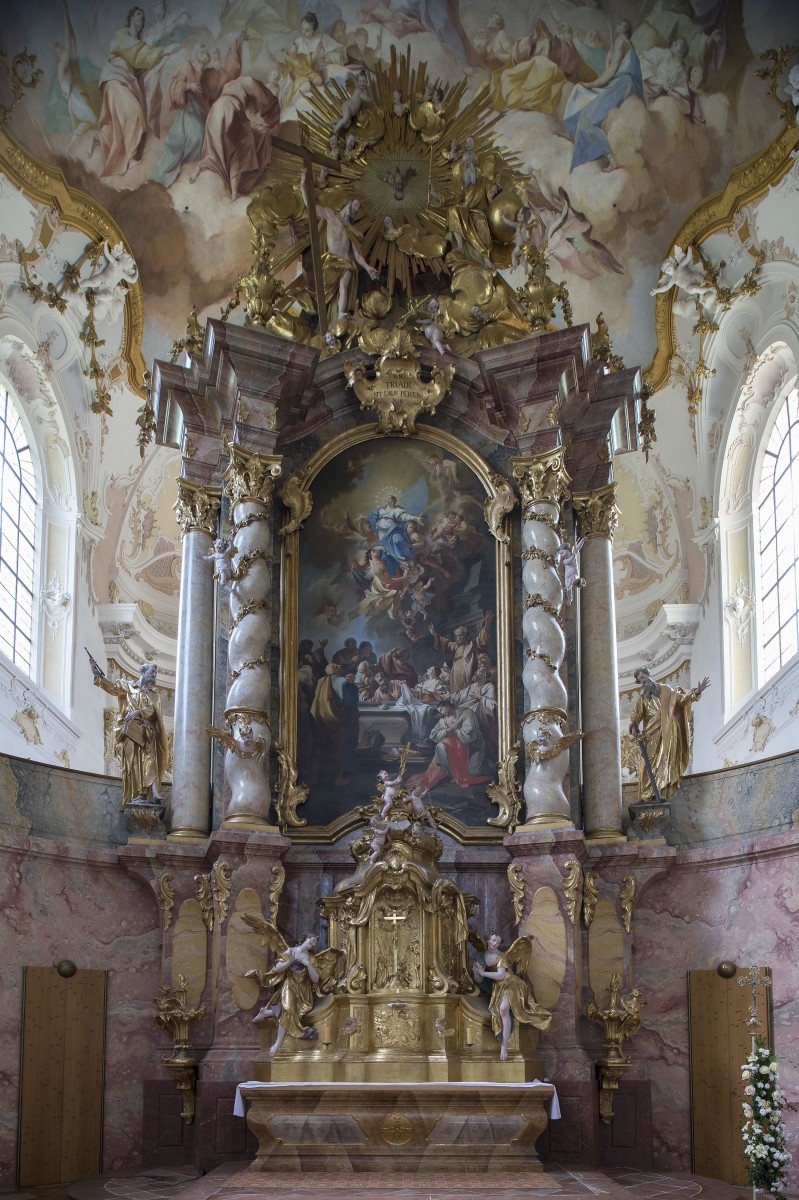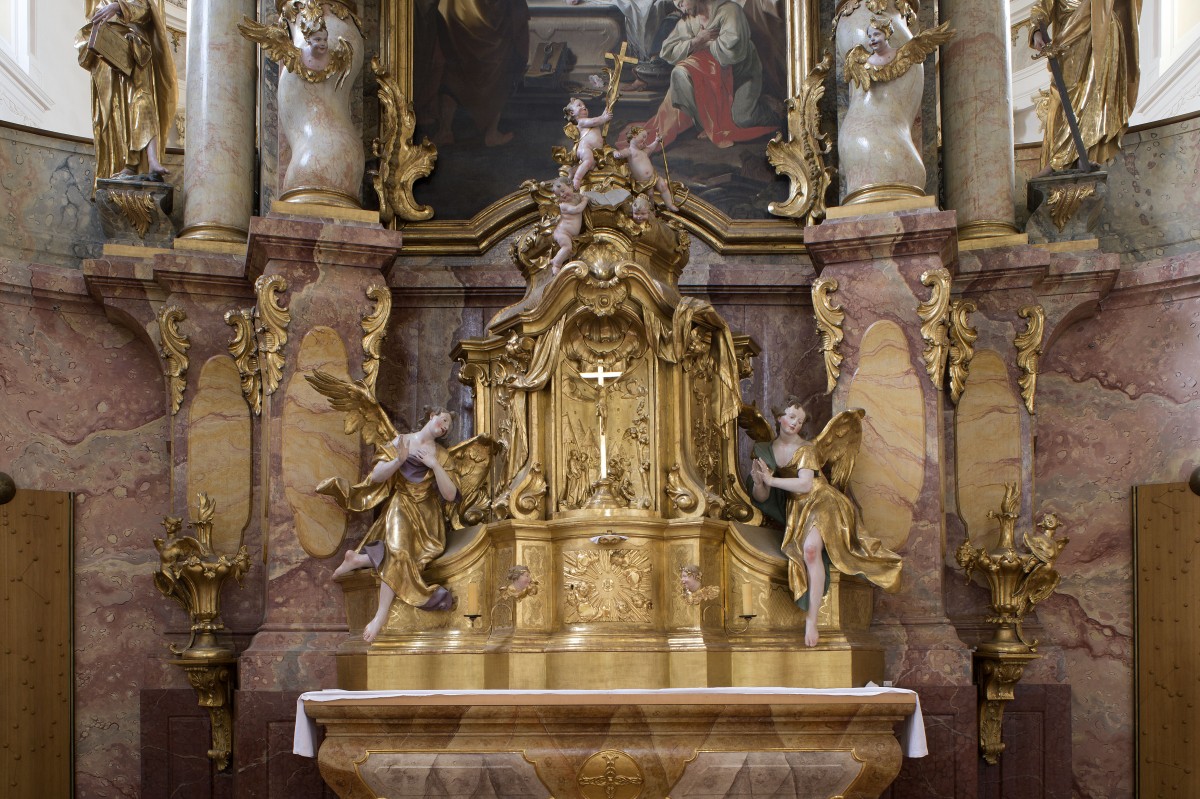Location
Germany, Bavaria, Fürstenzell
Former Cistercian abbey church, today the Catholic Parish Church of the Assumption of Mary in Fürstenzell (Ehem. Zisterzienser-Abteikirche und heutige kath, Pfarrkirche Maria Himmelfahrt in Fürstenzell)
Kath. Pfarrgemeinde Maria Himmelfahrt in Fürstenzell
Artwork
The High Altar and the Tabernacle of the Catholic Parish Church (former Cistercian abbey church) of the Assumption of Mary in Fürstenzell
Type
High altar
Dimensions
Height: 1120 cm, width: 720 cm
Inscriptions
- Cartouche under the figures of the Trinity on the top: S.S. TRIADI SIT LAUS PERENNIS
Critical History
The high altar, the tabernacle and two sketches are archivally testified works of J.B. Straub
The construction of the church began in 1739 under Abbot Stephan Mayr (1727–1761) and was continued in 1740 by the Munich architect Johann Michael Fischer with a new plan using the foundations.1 Fischer also acted as a costumer and coordinator of the monastery for all equipment.
In 1741, the tabernacle was commissioned by Fischer, made 1741 by J. B. Straub and delivered in 1743. Straub received 400 fl.2. Probably it was painted in 1745, together with the altar.
Also in 1741, choir stalls were ordered from Straub.3
In 1744/5, the high altar was made according to plans by Straub, by the carpenter Jakob Kalchgrueber and the Vilshofener painter Andreas Math within five months of 1745. The exchange of sketches between Munich and Fürstenzell is documented, and in 1744 Straub visited Fürstenzell. It can be assumed that the sketches were coordinated with Fischer. Straub received 755 fl. for the sculptures. The Vilshofener sculptor Wolfgang Reittmayr finally enlarged the curtain of the high altar, made consoles for the two tabernacle vases, and a pedestal for the tabernacle monstrance.
The altarpiece was painted by Johann Jakob Zeiller in 1745.
No longer preserved are the choir stalls designed by Straub, which were executed between 1741 and 1745.
In 1744, the church was blessed, and it was consecrated in 1748.
1856, oil-bound overpainting of the high altar.
1898/9, complete renovation of the church. New painting of the high altar 1899.
1956/7, the high altar was partly newly painted.
According to the report of Thomas Schoeller from March 1994, the original version of the altar was "light pink, impasto ... with strong brush structures".4 The original incarnate and hair were visible. The original version was largely uncovered in 1994.
- Sketch for the high altar, left half, black feather, pencil preliminary drawing, inscription: "Wan disser altar gemacht wirdt so schnidt man in der mit von / ein ander vndt schikht mir den halben Thail undt zwar disse Seiten" and measure: "Münchner schu", 74.7 : 24 cm, Frankfurt/Main, Städelsches Kunstinstitut, Z 15294 5. Peter Volk, fig. 35
- Sketch for altar table and tabernacle of the high altar with side passages, black feather, watercoloured, 25.7 : 27.1 cm, München Staatliche Graphische Sammlung, 30495; H-M V, 86 6. Peter Volk 1984, fig. 36
Altar arrangement over a high pedestal, staggered in depth with slightly tilted, lateral, straight and spiral columns standing in front, the cornice raised above the altarpiece. At the sides of the outer altar columns are the two statues of Apostles Peter and Paul. The excerpt depict the Trinity in front of a gloriole. Above the original painting of the Assumption of the Virgin Mary (Zeiller 1745) and the inscription cartouche a putto is holding a sceptre and a crown on a pillow. The high pedestal refers to the architectural structure of the sanctuary and the original floor level of the monks' choir before transferring the altarpiece in the 19th century.
The tabernacle has a relief of the Mannalese, at the side are adoring angels and above cherubs with the attributes of faith, love and hope.
Construction / Execution
Wood, cpainted in naturalistic incarnation, the altar architecture is marbled. The clothes are partly gilded, the tabernacle and gloriole are completely gilded.
The entire setting was transposed in the 20th century based on the original Baroque arrangement.
Components
- Carpentry
- Author: Jakob Kalchgrueber
- Completed: ca. 1744 – ca. 1745
- Patron(s): owner, parish
- Technique(s): wood carving
- Material(s): softwood
- Sculpture
- Author: Johann Baptist Straub (Wiesensteig ca. 1704 – Munich 1784)
- Completed: ca. 1741 – ca. 1745
- Patron(s): owner, parish
- Technique(s): wood carving
- Material(s): softwood
- Polychromy
- Author: Andreas Math
- Completed: ca. 1745 – ca. 1745
Comment
The altar originally stood in front of a partition in the middle of the monks' choir. In September 1856, it was transferred without dismantling to the end of the choir. At the same time the altar table, which was originally more curved, was altered and the disposition between the tabernacle and the retable changed.7 Probably there were also side passages before the transfer. This is supported by Lippert's mention of six altar figures, in 1772.8 Notable in this context is also the different shaping of the postaments of the two lateral figures.
In the course of the last interior renovation, the high altar was in 1999 transposed back to its original place in the middle of the choir, the two former lateral endings were rebuilt. Today they look very massive in their simplicity. The high altar and the figures were uncovered of overpaintings from the fifties and brought closer to their condition in the 18th century. The figures on the high altar now show the original painting. In the gilding we have to a great extent the state from 1939 and 1956.
Conservation-restoration
- 1856
Treatment Description
1856, oil-bound overpainting of the high altar.
- 1898–1899
Treatment Description
Comprehensive renovations of the inner space in 1898/99. Giedion-Welcker regrets the work on the altar as a tactless overpainting.9
- 1956
Treatment Description
Comprehensive renovations of the inner space took place in 1956. Dislocation of the high altar from its original to a more advanced position.
- 1994–2000
Treatment Description
Dislocation of the high altar back to its former position.
Archival compilation of the interior equipment, Friedl Brunkhorst, 1994, BLfD München
Organ and high altar: Examination reports, reports on sample areas and findings (with copy), cost overview, Thomas Schoeller, München, 1994 - 2000, photo documentation with b / w photos, BLfD München
Report on the creation of samples, Martin Zunhammer, Altötting, 2000
- 1998
Strategy: removing partial repairs
Treatment Description
Wardrobe at the back of the high altar: Investigation Report (Preis & Preis 1998)
- 1999
Approach to the presentation of losses
Reconstruction of losses: partial
Treatment Description
High altar – altar support panelling: reconstruction according to colour photos and slides.
- 1999
Strategy: removing varnish
Treatment Description
High altar: plans for stabilization and change of location (Bergmann 1999). Records of altars, etc. 1991ff.
Images
- High altar of the Catholic Parish Church (former Cistercian abbey church) of the Assumption of Mary in Fürstenzell (Bavarian State Department of Monuments and Sites, photo by Michael Forstner, 2017)
- Tabernacle of the high altar of the Catholic Parish Church (former Cistercian abbey church) of the Assumption of Mary in Fürstenzell (Bavarian State Department of Monuments and Sites, photo by Michael Forstner, 2017)
Catalogue entry prepared by Martin Mannewitz
Recommended citation: Martin Mannewitz, The High Altar and the Tabernacle of the Catholic Parish Church (former Cistercian abbey church) of the Assumption of Mary in Fürstenzell, in: TrArS – Tracing the Art of the Straub Family, 2018, (accessed 25/10/2025) URL


